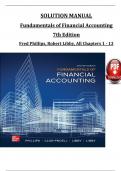SOLUTION MANUAL Fundamentals of Financial Accounting 7th Edition Fred Phillips, Robert Libby, All Chapters 1 - 13 TABLE OF CONTENTS CHAPTER 1: Business Decisions and Financial Accounting CHAPTER 2: The Balance Sheet CHAPTER 3: The Income Statement CHAPTER 4: Adjustments, Financial Statements, and Financial Results CHAPTER 5: Fraud, Internal Control, and Cash CHAPTER 6: Merchandising Operations and the Multi-step Income Statement CHAPTER 7: Inventory and Cost of Goods Sold CHAPTER 8: Receivables, Bad Debt Expense, and Interest Revenue CHAPTER 9: Long-Lived Tangible and Intangible Assets CHAPTER 10: Liabilities CHAPTER 11: Shareholders' Equity CHAPTER 12: Statement of Cash Flows CHAPTER 13: Measuring and Evaluating Financial Performance Chapter 1 Business Decisions and Financial Accounting ANSWERS TO QUESTIONS 1. Accounting is a system of analyzing, recording, and summarizing the results of a business ‘s activities and then reporting them to decision makers. 2. An advantage of operating as a sole proprietorship, rather than a corporation, is that it is easy to establish. Another advantage is that income from a sole proprietorship is taxed only once in the hands of the individual proprietor (income from a corporation is taxed in the corporation and then again in the hands of the individual proprietor). A disadvantage of operating as a sole proprietorship, rather than a corporation, is that the individual proprietor can be held responsible for the debts of the business. 3. Financial accounting focuses on preparing and using the financial statements that are made available to owners and external users such as customers, creditors, and potential investors who are interested in reading them. Managerial accounting focuses on other accounting reports that are not released to the general public, but instead are prepared and used by employees, supervisors, and managers who run the company. 4. Financial reports are used by both internal and external groups and individuals. The internal groups are comprised of the various managers of the business. The external groups include investors, creditors, governmental agencies, other interested partie s, and the public at large. 5. The business itself, not the individual shareholders who own the business, is viewed as owning the assets and owing the liabilities on its balance sheet. A business ‘s balance sheet includes the assets, liabilities, and shareholders ‘ equity of only that business and not the personal assets, liabilities, and equity of the shareholders. The financial state ments of a company show the results of the business activities of only that company. 6. (a) Operating – These activities are directly related to earning profits. They include buying supplies, making products, serving customers, cleaning the premises, advertising, rent ing a building, repairing equipment, and obtaining insurance coverage. (b) Investing – These activities involve buying and selling productive resources with long lives (such as buildings, land, equipment, and tools), purchasing investments, and lending to others. (c) Financing – Any borrowing from banks, repaying bank loans, receiving contributions from shareholders, or paying dividends to shareholders are considered financing activities. 7. The heading of each of the four primary financial statements should include the following: (a) Name of the business (b) Name of the statement (c) Date of the statement, or the period of time 8. (a) The purpose of the balance sheet is to report the financial position (assets, liabilities and shareholders ‘ equity) of a business at a point in time. (b) The purpose of the income statement is to present information about the revenues, expenses, and net income of a business for a specified period of time. (c) The statement of retained earnings reports the way that net income and the distribution of dividends affected the financial position of the company during the period. (d) The purpose of the statement of cash flows is to summarize how a business ‘s operating, investing, and financing activities caused its cash balance to change over a particular period of time. 9. The income statement, statement of retained earnings, and statement of cash flows wou ld be dated ―For the Year Ended December 31, 2020 ,‖ because they report the inflows and outflows of resources during a period of time. In contrast, the balance sheet would be dated ―At December 31, 2020, ‖ because it represents the assets, liabilities and shareholders ‘ equity at a specific date. 10. Net income is the excess of total revenues over total expenses. A net loss occurs if total expenses exceed total revenues. 11. The accounting equation for the balance sheet is: Assets = Liabilities + Share holders ‘ Equity. Assets are the economic resources controlled by the company. Liabilities are amounts owed by the business. Shareholders ‘ equity is the owners ‘ claims to the business. It includes amounts contributed to the business (by investors through purchasing the company ‘s shares) and the amounts earned and accumulated through profitable business operations. 12. The equation for the income statement is Revenues – Expenses = Net Income. Revenues are increases in a company ‘s resources, arising primarily from its operating activities. Expenses are decreases in a company ‘s resources, arising primarily from its operating activities. Net Income is equal to revenues minus expenses. (If expenses are greater than revenues, the company has a Net Loss.)




